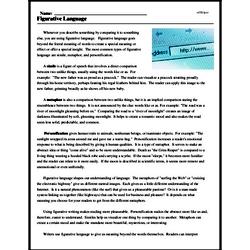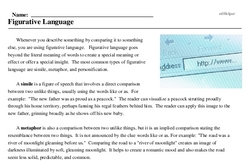Figurative Language
Whenever you describe something by comparing it to something else, you are using figurative language. Figurative language goes beyond the literal meaning of words to create a special meaning or effect or offer a special insight. The most common types of figurative language are simile, metaphor, and personification.
A simile is a figure of speech that involves a direct comparison between two unlike things, usually using the words like or as. For example: "The new father was as proud as a peacock." The reader can visualize a peacock strutting proudly through his home territory, perhaps fanning his regal feathers behind him. The reader can apply this image to the new father, grinning broadly as he shows off his new baby.
A metaphor is also a comparison between two unlike things, but it is an implied comparison stating the resemblance between two things. It is not announced by the clue words like or as. For example: "The road was a river of moonlight gleaming before us." Comparing the road to a "river of moonlight" creates an image of darkness illuminated by soft, gleaming moonlight. It helps to create a romantic mood and also makes the road seem less solid, predictable, and common.




